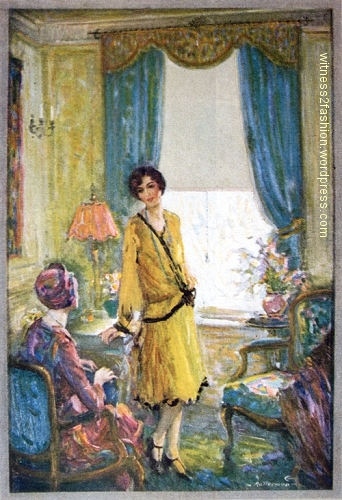
Orange and black on the cover of Delineator magazine, October 1921.
It’s been some time [Oct. 5, 2014] since I first wrote about the popularity of an orange and black combination for everyday wear in the early 1920s. It wasn’t just for October, and it didn’t necessarily evoke thoughts of Hallowe’en in those days. Here are a few examples:

This ensemble is from February 1920. Delineator.
A chic summer coat:

This boldly orange, black, and white coat dates to August 1921. Note her matching orange veil! Delineator.

Full length view of coat, Delineator, August 1921.
The woman next to her wears orange-ish plaid:

The effect is orange-y, although one could argue that it’s ochre and rust….

This orange and black dress is topped with an orange and black hat.

November, 1921; Delineator.

The black skirt has an orange lining on the side drape, and the collar is black, with black embroidery on the bodice.
Orange dress, black hat, 1921:

This orange dress is beaded in darker orange. October 1921, Delineator.

Butterick also sold beading patterns. This is dress 3303 with embroidery design 10921.
If you’re not familiar with Delineator Magazine, it was published by Butterick and contained many articles and fiction as well as pages and pages of featured Butterick sewing patterns. Issues of the magazine going back to the 1880s can be found online at Google’s Hathi Trust. They are searchable.

Two dresses from Delineator, April 1922.
Both theses Spring outfits feature the orange and black color combination.

The dress on the right seems to have a self-bias-tape lattice trim worn over a black slip or underdress. (A slip intended to show was made of dress fabric and called a “costume slip.”
This black winter dress is embroidered and lined in burnt orange for a subtle zing.

Delineator, January 1922.

January, 1922.
Another black costume, this time a sheer tunic for evening, has touches of red-orange embroidery accenting sleeves, bodice, and borders:

A sheer tunic top over a black “costume slip.”

Details of tunic 3462. January, 1922. Delineator.

Black and orange for Spring:

A suggested costume for April, 1922. Delineator.
It depends on a printed fabric in white, black, blue and orange for its contrast sleeves and belt.

Even tennis clothes could be colorful, like this blouse from August 1922:

Blouse, Delineator, August 1922.
Children could wear orange and black any time of the year:

Girl’s dress embroidered in black, with matching bloomers. December 1922, Delineator.
If you’re desperate for a costume idea, how about Little Orange Riding Hood?

Little Orange Riding Hood; October 1921. Delineator.





























